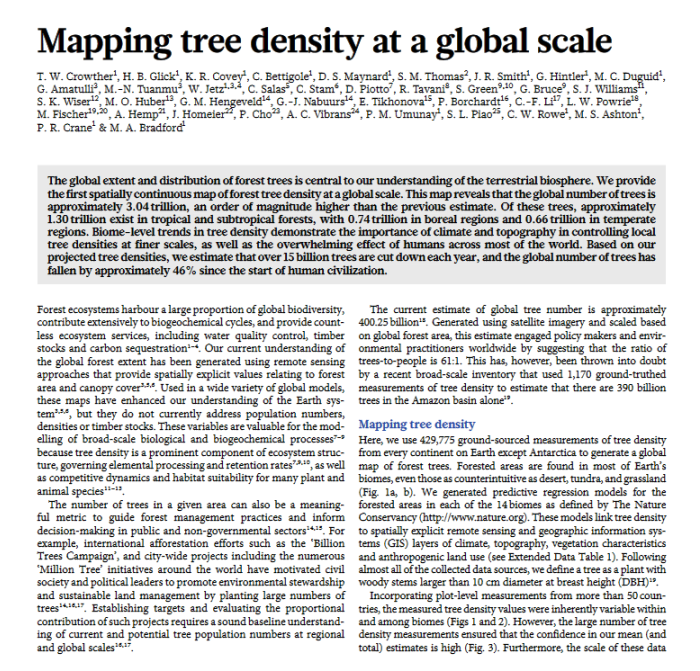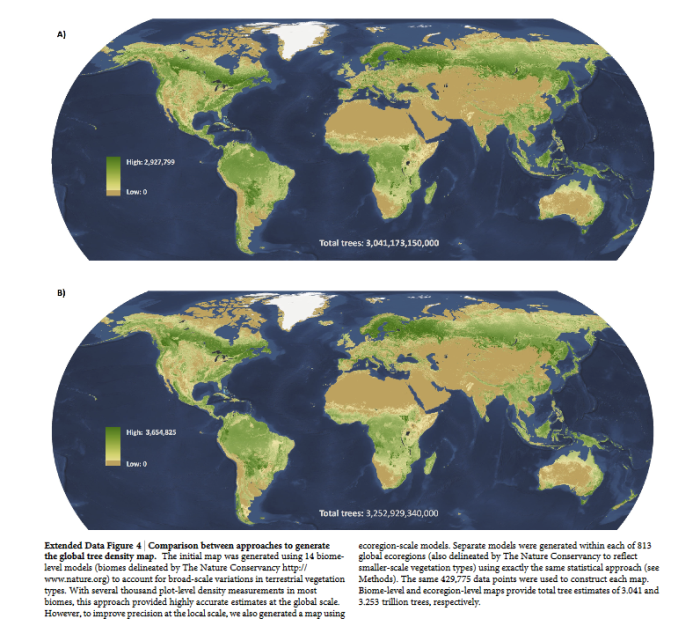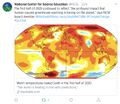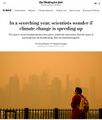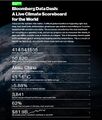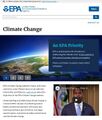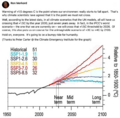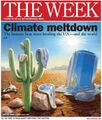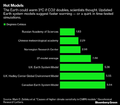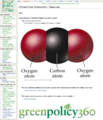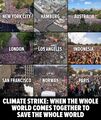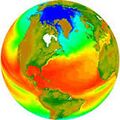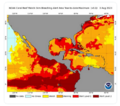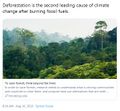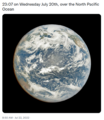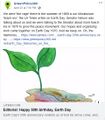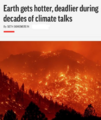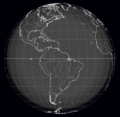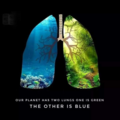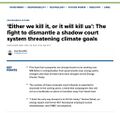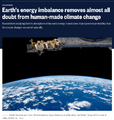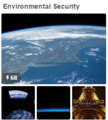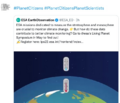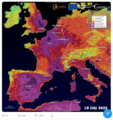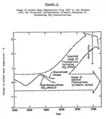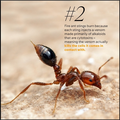Category:Forests: Difference between revisions
Siterunner (talk | contribs) No edit summary |
Siterunner (talk | contribs) No edit summary |
||
| Line 29: | Line 29: | ||
[[File:Mapping Tree Density 1.png]] | |||
[[File:Mapping Tree Density 2.png]] | |||
○ | |||
[[Category:Atmospheric Science]] | |||
[[Category:Biodiversity]] | [[Category:Biodiversity]] | ||
[[Category:Carbon Sequestration]] | [[Category:Carbon Sequestration]] | ||
[[Category:Climate Change]] | [[Category:Climate Change]] | ||
[[Category:Earth Science]] | |||
[[Category:Environmental Security]] | [[Category:Environmental Security]] | ||
[[Category:Forest]] | [[Category:Forest]] | ||
Revision as of 20:45, 23 December 2016
August 2015
http://news.sciencemag.org/plants-animals/2015/08/special-issue-forest-health-changing-world
Forests and woodlands cover about 20% of Earth's land surface, spanning all but the highest latitudes. In the millennia since humans dispersed across all forested continents, we have transformed large areas of natural forest. Historically, our greatest impacts were made in temperate regions, but they now extend to forests in the tropics and the boreal zone. Only a fraction of the forests present centuries ago have escaped human influence; in many regions the forest is gone, has regrown as secondary forest, or consists of managed and plantation forests. Humans have also introduced new species, including pests and pathogens of trees. Other influences — such as climate warming that causes tree species to shift geographically and anthropogenic drought that causes forest dieback — take effect more slowly...
News/Updates
Via National Science Foundation
February 2016
US Forests nationwide are feeling the heat from increasing drought and climate change, according to a new study by scientists from 14 research institutions.
"Over the last two decades, warming temperatures and variable precipitation have increased the severity of forest droughts across much of the continental United States," said James Clark, lead author of the study and an environmental scientist at Duke University.
Clark and colleagues published their paper today in the journal Global Change Biology.
"While the effects have been most pronounced in the West, our analysis shows virtually that all U.S. forests are now experiencing change and are vulnerable to future declines..."
http://www.eurekalert.org/pub_releases/2016-02/du-nau022216.php
https://www.nsf.gov/news/news_summ.jsp?cntn_id=132709
http://media.eurekalert.org/multimedia_prod/pub/web/109533_web.jpg
○
Subcategories
This category has the following 8 subcategories, out of 8 total.
B
E
F
N
R
Pages in category "Forests"
The following 65 pages are in this category, out of 65 total.
C
E
F
G
- Glasgow Climate Summit - Pledges, Promises, Declarations - What's Next Up
- Global Forest Watch
- Google Earth
- Green New Deal
- Green Stories of the Day
- Green Stories of the Day - GreenPolicy360 Archive
- GreenPolicy360 Archive Highlights 2013
- GreenPolicy360 Archive Highlights 2014
- GreenPolicy360 Archive Highlights 2015
- GreenPolicy360 Archive Highlights 2016
- GreenPolicy360 Archive Highlights 2017
- GreenPolicy360 Archive Highlights 2018
- GreenPolicy360 Archive Highlights 2019
- GreenPolicy360 Archive Highlights 2020
- GreenPolicy360 Archive Highlights 2023
P
Media in category "Forests"
The following 200 files are in this category, out of 492 total.
(previous page) (next page)- 2020 record temperatures.png 800 × 502; 358 KB
- 3M lawsuit re forever chemicals - June 2023.png 603 × 600; 357 KB
- 7-20-2020 GreenPolicy360 RT No.2.jpg 591 × 510; 125 KB
- A root and its mycorrhizal fungus surroundings.PNG 315 × 382; 236 KB
- A scorching year, what about the 360 warming data.jpg 600 × 706; 106 KB
- About Baselines and Change.png 592 × 312; 33 KB
- Acceptance on behalf of the United States of America.png 448 × 306; 62 KB
- Act now for a livable future.png 501 × 275; 272 KB
- Agroforestry-2.jpg 752 × 600; 149 KB
- Amazon deforestation timeline.jpg 800 × 417; 64 KB
- Amazon fires burn across the rainforest.jpg 800 × 504; 76 KB
- Amazon, the violent destruction - Aug 2022.png 640 × 285; 199 KB
- Amazon-rainforest.jpg 814 × 459; 142 KB
- AOC March 26, 2019.jpg 597 × 433; 58 KB
- AOC re climate task force - july 8 2020.jpg 585 × 203; 38 KB
- April 28, 2016.png 586 × 415; 159 KB
- Arbor Day tree tips.jpg 800 × 442; 189 KB
- Argentina chaco forest change to livestock and crops.jpg 720 × 480; 310 KB
- AskNatureAvatar s.png 200 × 200; 14 KB
- Aspen Trees Fall Colors Web-of-Roots Connected Wiki commons.jpg 800 × 533; 171 KB
- At st peters endangered species.png 717 × 431; 242 KB
- Atmosphere Science.jpg 800 × 600; 45 KB
- Atmospheric Experiment of Humanity.jpg 519 × 574; 201 KB
- Audubon study ms.png 529 × 434; 437 KB
- Banking - finance - climate - Mann-1.jpg 452 × 640; 162 KB
- Banking - finance - climate - Mann-2.jpg 452 × 640; 164 KB
- Battle for Democracy.jpg 640 × 123; 24 KB
- Bernie Sanders, Senate 2.PNG 800 × 517; 379 KB
- Bernie Sanders, Senate Aug 3.PNG 800 × 518; 388 KB
- Biden introduces leadership team - Nov 24 2020.jpg 800 × 644; 173 KB
- Biden re Earth Day 2023.png 640 × 400; 155 KB
- Biden selects Kerry as special climate envoy.jpg 592 × 505; 87 KB
- Biden urged to act - Oct 18 2021 - The Guardian.png 663 × 600; 497 KB
- Biden's assembled an all-star climate team 4-21-2021.jpg 682 × 732; 309 KB
- Biden-Sanders Unity Task Force on Climate.jpg 701 × 780; 139 KB
- Big Oil Rocked by News May 27 2021.jpg 639 × 600; 84 KB
- Big Wobble 2020.jpg 507 × 342; 79 KB
- Biggest climate related legislation in history - 1.png 800 × 188; 68 KB
- Bill Nelson on Global Temp Rise and Climate Change.png 640 × 353; 100 KB
- Bill Nye The Planet's on Fire.jpg 800 × 675; 106 KB
- Bloomberg Carbon Clock 10-26-2021 8-47-05 AM EST.png 800 × 195; 356 KB
- Bloomberg Live Climate Data Dashboard.jpg 640 × 756; 156 KB
- Brazil Amazon deforestation - circa 2022.png 688 × 600; 397 KB
- Breakpoint - Reckoning with America's Environmental Crisis.jpg 329 × 500; 49 KB
- Bug eyes in the rainforest canopy Photo by Don Perry-2.jpg 300 × 576; 24 KB
- Bug eyes in the rainforest canopy Photo by Don Perry.jpg 391 × 576; 27 KB
- Burst of climate denial as Trump presidency ends.jpg 632 × 604; 92 KB
- California's kelp forests and coastal biodiversity diminished.png 532 × 754; 307 KB
- Car heating and cooling.png 465 × 635; 261 KB
- Carbon Brief - Greenhouse gas levels 2021.png 640 × 436; 292 KB
- Carl Sagan at the Emerging Issues Forum - 1990.png 360 × 460; 192 KB
- Carl Sagan at the Emerging Issues Forum.png 747 × 600; 600 KB
- Carl Sagan, 1985.PNG 480 × 566; 331 KB
- Carl Sagan, the atmosphere unifies and connects all of our world.png 360 × 390; 229 KB
- Caroline Lucas-Green New Deal.jpg 584 × 391; 71 KB
- CFSV2 world temp July 3, 2023.png 600 × 800; 513 KB
- CH4 graph - 1980-2020.JPG 640 × 446; 22 KB
- Challenge of Acting for the Commons.png 700 × 548; 175 KB
- Changes in carbon dioxide per 1000 years - via Climate Central.jpg 682 × 424; 34 KB
- China Record Heat - August 2022.png 800 × 1,343; 812 KB
- Citizens Climate Lobby - Save Our Future Act 2021.jpg 518 × 262; 77 KB
- Climate Action 25th conf in Madrid.jpg 680 × 510; 22 KB
- Climate activist - Steven Schmidt - 1978 on.png 600 × 480; 174 KB
- Climate Books - 2020.jpg 800 × 450; 69 KB
- Climate Change COP27 - Nov 11 2022 US Representatives.jpg 712 × 444; 54 KB
- Climate Change COP27 - Nov 11 Kathy Castor.jpg 712 × 710; 77 KB
- Climate Change US EPA.jpg 600 × 703; 95 KB
- Climate Conferences 1979-2020.jpg 768 × 768; 121 KB
- Climate Crisis - Emily Atkin Heated No. 1.jpg 537 × 453; 61 KB
- Climate Crisis and the Global Green New Deal.jpg 293 × 418; 33 KB
- Climate Desk.jpg 390 × 226; 21 KB
- Climate diplomacy is failing - June 2020.jpg 592 × 440; 71 KB
- Climate Emergency Institute - Oct 2022.png 610 × 600; 274 KB
- Climate Emergency Institute -- 2021.jpg 800 × 450; 55 KB
- Climate emergency.jpg 800 × 450; 69 KB
- Climate Goals off course - 2018.png 800 × 556; 214 KB
- Climate Headline News around the World - July 2023.jpg 600 × 704; 151 KB
- Climate Models.png 639 × 558; 123 KB
- Climate News - Oct 28 2022.jpg 626 × 600; 88 KB
- Climate News - United Nations Report - Feb 2022.png 768 × 878; 539 KB
- Climate News Dec 4 2023 in Dubai.png 800 × 1,037; 649 KB
- Climate Plans Enforcement - Resources - GreenPolicy.png 768 × 897; 686 KB
- Climate poll - Florida.png 640 × 267; 36 KB
- Climate strike - Week 171.png 739 × 600; 834 KB
- Climate Strike Around the World - Sep20,2019.jpg 700 × 830; 119 KB
- Climate Summit - Leonardo DiCaprio.png 600 × 663; 521 KB
- Climate Summit live updates - Nov 2 2021.png 751 × 600; 420 KB
- Climate Summit planned-1.jpg 800 × 301; 53 KB
- Climate Summit planned-2.jpg 800 × 187; 31 KB
- Climate Summit planned-3.jpg 800 × 278; 44 KB
- Climate Summit planned-4.jpg 800 × 241; 41 KB
- ClimateNews 360.jpg 172 × 172; 9 KB
- ClimateNewsFlorida.jpg 448 × 191; 36 KB
- CO2 at Mauna Loa data - June 02, 2020 - 417.90 ppm.jpg 640 × 566; 66 KB
- CO2 cumulative emissions 1850 - 2021 - countries.jpg 640 × 462; 211 KB
- CO2 emissions-around-the-world.png 800 × 595; 123 KB
- CO2 global pathways via IPCC AR6 - how will we respond.jpg 800 × 450; 57 KB
- Commons-concepts permanent culture now s.png 448 × 211; 75 KB
- Commons-concepts permanent culture now.png 830 × 391; 39 KB
- Congo percent forest cover gsfc nasa.jpg 1,382 × 778; 191 KB
- Connect with Nature.png 405 × 280; 17 KB
- COP26 Climate Summit concludes.jpg 600 × 800; 160 KB
- COP26 concludes - 2.png 648 × 467; 177 KB
- COP26 concludes - 3.png 648 × 713; 416 KB
- COP26 concludes.png 648 × 528; 329 KB
- COP26 in GLASGOW - 31 OCT-12 NOV 2021.jpg 800 × 264; 51 KB
- COP27 'opening speech'.png 640 × 460; 160 KB
- COP28 News - Dec 13 2023.png 800 × 898; 410 KB
- CopernicusEU - Sentinel5P Atmosphere Monitoring Mission - 2.jpg 795 × 1,477; 654 KB
- CopernicusEU - Sentinel5P Atmosphere Monitoring Mission.png 583 × 465; 222 KB
- Coral bleaching - August 2023.png 488 × 430; 261 KB
- Coral bleaching - NOAA - August 2023.png 488 × 338; 201 KB
- Covering Climate Now.jpg 493 × 498; 67 KB
- Cradle of Civilization - and climate change.jpg 640 × 360; 70 KB
- Cradle to Cradle Products Innovation Instit.jpg 600 × 600; 72 KB
- Cube Launch from the ISS via Tim Peake.png 640 × 409; 218 KB
- Dated record of Earths climate - Science Report Sept 10 2020.jpg 735 × 669; 192 KB
- David-brower-environmental-movement-cover.jpg 530 × 800; 89 KB
- Death Valley ... the heat, what its like.jpg 640 × 381; 62 KB
- Defend Our Future 6-1-2020.jpg 585 × 458; 103 KB
- Deforestation no.jpg 596 × 550; 117 KB
- Democratic Climate Plan-Introduced June 2020.jpg 528 × 561; 117 KB
- Democratic National Convention-62 climate speakers.jpg 443 × 407; 57 KB
- Democratic Party Climate Bill - Aug 2022.png 640 × 269; 70 KB
- DJT - US message to world.jpg 800 × 266; 45 KB
- Don Perry In the Canopy first-gen canopy web.jpg 720 × 487; 81 KB
- DON PERRY RAIN-FOREST-AERIAL-TRAM m.jpg 475 × 707; 139 KB
- Don Perry SmithsonianCover.jpg 700 × 967; 873 KB
- Don Perry-credit-Roberta-Halsey.jpg 645 × 960; 114 KB
- Don't Look Up ....jpg 430 × 543; 172 KB
- Don't Look Up.jpg 800 × 450; 104 KB
- Donald Trump-Jair Bolsonaro-March 2019.jpg 640 × 455; 57 KB
- Dove1 image.jpg 420 × 308; 26 KB
- DSCOVR EPIC - July 20 2022.png 532 × 612; 315 KB
- Earth AI - Feb 2022.png 482 × 480; 192 KB
- Earth Breathing.jpg 800 × 450; 117 KB
- Earth Day 2021 - Climate Summit News-1.jpg 491 × 270; 127 KB
- Earth Day 50 years on.jpg 480 × 548; 107 KB
- Earth Day Flag.png 400 × 267; 69 KB
- Earth Information Center - 2022 Graphic NASA.png 800 × 981; 868 KB
- Earth Information Center from NASA.jpg 800 × 577; 94 KB
- Earth mapped.png 800 × 783; 254 KB
- Earth Observing System - fleet of satellites.png 740 × 576; 557 KB
- Earth POV from the ISS Cupola-m.jpg 800 × 480; 71 KB
- Earth Summit 1992-s.png 336 × 418; 283 KB
- Earth Summit 1992.jpg 600 × 746; 171 KB
- Earth System Observatory-1.jpg 580 × 833; 129 KB
- Earth System Observatory-2.jpg 580 × 831; 69 KB
- Earth trapping unprecedented amount of heat - NASA.jpg 468 × 373; 56 KB
- Earth Viewing from the International Space Station.jpg 496 × 307; 45 KB
- EARTH-ISLAND-LOGO.png 314 × 148; 12 KB
- Earth-upper-atmosphere-NASA.jpg 800 × 781; 327 KB
- Earths two lungs.png 336 × 336; 130 KB
- EarthScience Missions via the EOS - 2022.png 800 × 219; 139 KB
- Economist.com global capital snapshot as of July 2020.jpg 800 × 477; 119 KB
- Ecostress Mission-Aug 2020.jpg 640 × 311; 85 KB
- ECOTRAM - Don Perry.png 800 × 474; 390 KB
- Elon Musk quote - gas externality price.png 680 × 320; 199 KB
- Energy Charter Treaty.jpg 512 × 480; 74 KB
- Energy Imbalance, Climate Change - Aug 1 2021.png 640 × 672; 394 KB
- Env policy laws US 'the beginning' of env era.jpg 370 × 345; 65 KB
- Environmental laws in US - Supreme Court votes soon.png 800 × 414; 334 KB
- Environmental Studies-Documerica.png 688 × 963; 522 KB
- EnvironmentalSecurity ThinBlue.png 223 × 248; 94 KB
- EO and Fire Ants in the US - on World Wildlife Day.png 768 × 811; 663 KB
- EPA and the Green Bank - Feb 2023.png 476 × 542; 244 KB
- ESA Living Planet Symposium - Announcement.png 637 × 600; 508 KB
- ESA Living Planet Symposium - May 2022.png 700 × 600; 258 KB
- ESG Fight - Feb 2023.png 396 × 194; 88 KB
- EU agrees to cut emissions 55 percent by 2030.jpg 800 × 558; 96 KB
- EU unveils new climate change policy - July 14 2021 - 1.jpg 800 × 234; 33 KB
- EU unveils new climate change policy - July 14 2021 - 2.jpg 800 × 552; 86 KB
- EU unveils new climate change policy - July 14 2021 - 3.jpg 800 × 549; 89 KB
- EU unveils new climate change policy - July 14 2021 - 4.jpg 800 × 550; 92 KB
- EU unveils new climate change policy - July 14 2021 - 5.jpg 800 × 548; 88 KB
- EU unveils new climate change policy - July 14 2021 - 6.jpg 800 × 557; 89 KB
- EU unveils new climate change policy - July 14 2021 - 7.jpg 800 × 553; 92 KB
- EU unveils new climate change policy - July 14 2021 - 8.jpg 800 × 589; 91 KB
- Eukaryotic Cell SCU.jpg 716 × 1,024; 799 KB
- Europe heat wave - July 19 2022 - via Copernicus satellite.png 600 × 639; 704 KB
- ExxonMobil CO2 climatic response study - Graphic 1 - 1982.png 537 × 680; 150 KB
- ExxonMobil CO2 climatic response study - Graphic 2 - 1982.png 537 × 605; 112 KB
- Eyes of the Animal 1a.png 905 × 471; 542 KB
- Fact Checking organizations at work.jpg 800 × 390; 44 KB
- Facts Count-WaPo Reports-19127 false-misleading claims in 1226 days.jpg 601 × 489; 100 KB
- Fire Ants.png 601 × 600; 603 KB
- Florida via NASA 2022.png 800 × 1,020; 1.12 MB
- Florida Wildlife Corridor - 2022 illustration.png 800 × 628; 473 KB
- Florida Wildlife Corridor FLWC Water Benefits December 2022.png 768 × 886; 109 KB
- Food-Forests-Living-poster by Molly Danielson.jpg 2,000 × 1,362; 405 KB
- Food-Forests-Living-poster by Molly Danielsson.jpg 800 × 545; 113 KB
